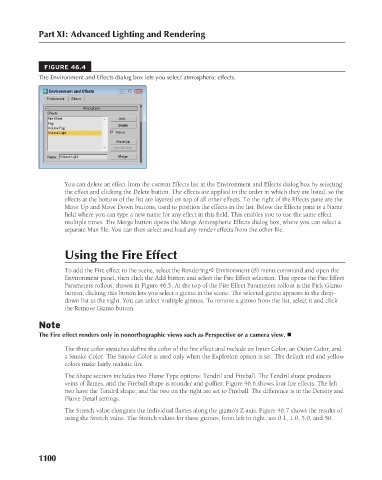Page 1148 - Kitab3DsMax
P. 1148
Part XI: Advanced Lighting and Rendering
FIGURE 46.4
The Environment and Effects dialog box lets you select atmospheric effects.
You can delete an effect from the current Effects list in the Environment and Effects dialog box by selecting
the effect and clicking the Delete button. The effects are applied in the order in which they are listed, so the
effects at the bottom of the list are layered on top of all other effects. To the right of the Effects pane are the
Move Up and Move Down buttons, used to position the effects in the list. Below the Effects pane is a Name
field where you can type a new name for any effect in this field. This enables you to use the same effect
multiple times. The Merge button opens the Merge Atmospheric Effects dialog box, where you can select a
separate Max file. You can then select and load any render effects from the other file.
Using the Fire Effect
To add the Fire effect to the scene, select the Rendering ➪ Environment (8) menu command and open the
Environment panel; then click the Add button and select the Fire Effect selection. This opens the Fire Effect
Parameters rollout, shown in Figure 46.5. At the top of the Fire Effect Parameters rollout is the Pick Gizmo
button; clicking this button lets you select a gizmo in the scene. The selected gizmo appears in the drop-
down list to the right. You can select multiple gizmos. To remove a gizmo from the list, select it and click
the Remove Gizmo button.
Note
The Fire effect renders only in nonorthographic views such as Perspective or a camera view. n
The three color swatches define the color of the fire effect and include an Inner Color, an Outer Color, and
a Smoke Color. The Smoke Color is used only when the Explosion option is set. The default red and yellow
colors make fairly realistic fire.
The Shape section includes two Flame Type options: Tendril and Fireball. The Tendril shape produces
veins of flames, and the Fireball shape is rounder and puffier. Figure 46.6 shows four fire effects. The left
two have the Tendril shape, and the two on the right are set to Fireball. The difference is in the Density and
Flame Detail settings.
The Stretch value elongates the individual flames along the gizmo’s Z-axis. Figure 46.7 shows the results of
using the Stretch value. The Stretch values for these gizmos, from left to right, are 0.1, 1.0, 5.0, and 50.
1100

